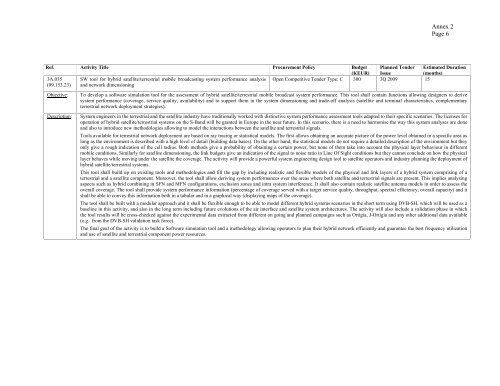ARTES-5.1 â ESA Telecom Technology Workplan ... - Emits - ESA
ARTES-5.1 â ESA Telecom Technology Workplan ... - Emits - ESA
ARTES-5.1 â ESA Telecom Technology Workplan ... - Emits - ESA
- No tags were found...
You also want an ePaper? Increase the reach of your titles
YUMPU automatically turns print PDFs into web optimized ePapers that Google loves.
Annex 2Page 6Ref. Activity Title Procurement Policy Budget(KEUR)Planned TenderIssueEstimated Duration(months)3A.035(09.153.23)SW tool for hybrid satellite/terrestrial mobile broadcasting system performance analysisand network dimensioningOpen Competitive Tender Type: C 300 3Q 2009 15Objective:Description:To develop a software simulation tool for the assessment of hybrid satellite/terrestrial mobile broadcast system performance. This tool shall contain functions allowing designers to derivesystem performance (coverage, service quality, availability) and to support them in the system dimensioning and trade-off analysis (satellite and terminal characteristics, complementaryterrestrial network deployment strategies).System engineers in the terrestrial and the satellite industry have traditionally worked with distinctive system performance assessment tools adapted to their specific scenarios. The licenses foroperation of hybrid satellite/terrestrial systems on the S-Band will be granted in Europe in the near future. In this scenario, there is a need to harmonise the way this system analyses are doneand also to introduce new methodologies allowing to model the interactions between the satellite and terrestrial signals.Tools available for terrestrial network deployment are based on ray tracing or statistical models. The first allows obtaining an accurate picture of the power level obtained in a specific area aslong as the environment is described with a high level of detail (building data bases). On the other hand, the statistical models do not require a detailed description of the environment but theyonly give a rough indication of the cell radius. Both methods give a probability of obtaining a certain power, but none of them take into account the physical layer behaviour in differentmobile conditions. Similarly for satellite dimensioning, the link budgets give an indication of the signal to noise ratio in Line Of Sight conditions but they cannot conclude on how the physicallayer behaves while moving under the satellite the coverage. The activity will provide a powerful system engineering design tool to satellite operators and industry planning the deployment ofhybrid satellite/terrestrial systems.This tool shall build up on existing tools and methodologies and fill the gap by including realistic and flexible models of the physical and link layers of a hybrid system comprising of aterrestrial and a satellite component. Moreover, the tool shall allow deriving system performances over the areas where both satellite and terrestrial signals are present. This implies analysingaspects such as hybrid combining in SFN and MFN configurations, exclusion zones and intra system interference. It shall also contain realistic satellite antenna models in order to assess theoverall coverage. The tool shall provide system performance information (percentage of coverage served with a target service quality, throughput, spectral efficiency, overall capacity) and itshall be able to convey this information both in a tabular and in a graphical way (displaying maps of the coverage).The tool shall be built with a modular approach and it shall be flexible enough to be able to model different hybrid systems scenarios in the short term using DVB-SH, which will be used as abaseline in this activity, and also in the long term including future evolutions of the air interface and satellite system architectures. The activity will also include a validation phase in whichthe tool results will be cross-checked against the experimental data extracted from different on going and planned campaigns such as Ortigia, J-Ortigia and any other additional data available(e.g. from the DVB-SH validation task force).The final goal of the activity is to build a Software simulation tool and a methodology allowing operators to plan their hybrid network efficiently and guarantee the best frequency utilizationand use of satellite and terrestrial component power resources.
















